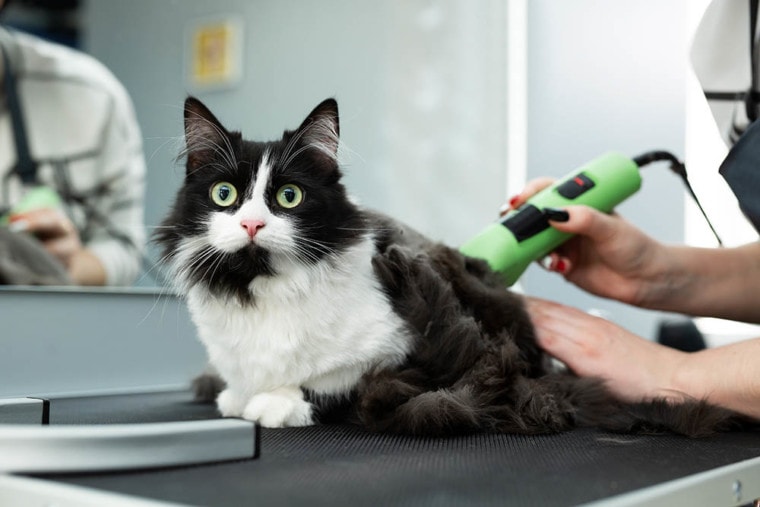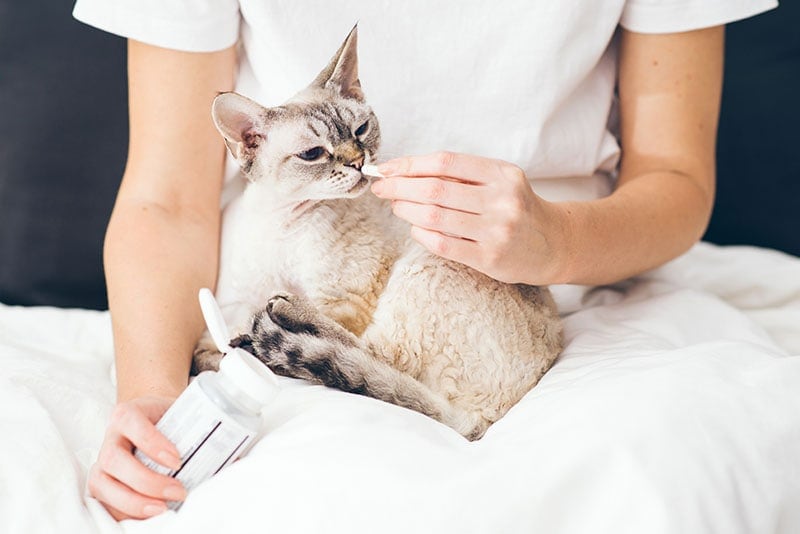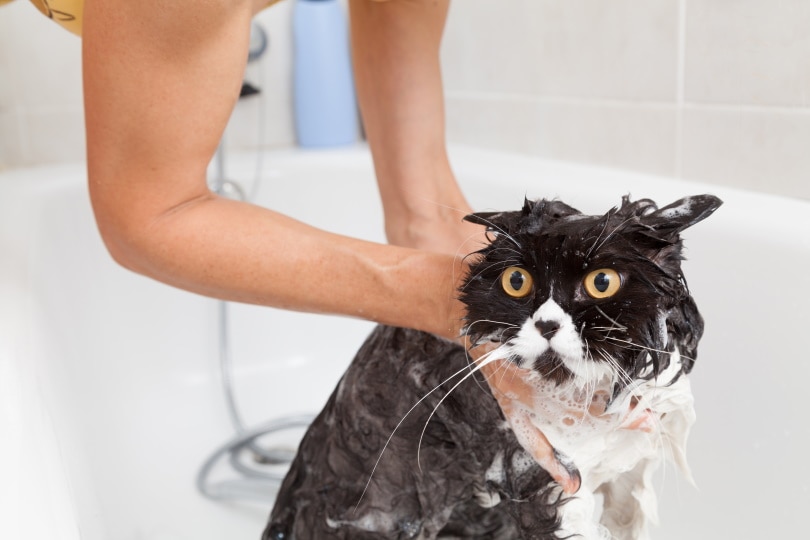
Cats usually don’t need help in the grooming department. This is something that they can take care of themselves. Regular baths aren’t necessary for most healthy cats.
However, nail clipping and haircuts will have to be done either by you or a professional. Sometimes cats simply get dirty. Walking around a freshly painted room or wandering out in the garage can get them covered in paint or grease. A bath will then be needed to get them clean again.
If your cat is anxious about being groomed, there are a few things that you can do to calm them. Read these tips and tricks for calming your cat for grooming to make the experience easier for both of you. There are additional tips for bathing your cat.
The 6 Tips and Tricks for Calming a Cat for Grooming
If you have a cat, you know that you’ll need to do at least a certain amount of grooming occasionally. Cats need help keeping their nails trimmed. Brushing their coats helps keep them shiny, smooth, and tangle-free. It also helps remove loose hair, which will otherwise end up around your house or in your cat’s stomach, turning into a hairball.
Here are a few ideas to try to make this whole process easier.
1. Start Slowly
Cats may feel anxious when we start the grooming process because it’s not something that we normally do. Straying from an established routine makes cats uncomfortable. Start slowly and don’t rush the process. If you don’t finish, you can always take a break and finish later.
Start by showing your cat the brush, comb, or nail clippers and allowing them to smell and examine them. This will help them realize that the grooming tools are not a threat to them. If you notice that your cat is anxious or nervous, try talking in a soothing tone, and once they are calm offer them their favorite treats as positive reinforcement.

2. Build a New Routine
Bringing out the brush regularly can help your cat learn that this is part of a new routine now and not something that they should fear. If possible, pick the same day of the week around the same time for regular brushing sessions.
Grooming your cat is a process that they either love or hate. If your kitty tends to despise their grooming sessions, you can make it a bit more enjoyable with our favorite brush on the market, the Hepper Cat Brush.
With its soft pins and a one-click button for easy clean-up, this brush is something that both you and your cat will enjoy.
At Pet Keen, we’ve admired Hepper for many years and decided to take a controlling ownership interest so that we could benefit from the outstanding designs of this cool cat company!
3. Pay Attention to Their Body Language
It may take a while for cats to feel relaxed. If their body language shows that they’re uncomfortable, it’s best to stop and give them a break.

4. Use a Pheromone Spray
Pheromone sprays can relax cats and ease their anxiety. Some cats do not react to them whatsoever, but they’re worth a try if you have a highly stressed cat. You can spray this on your hands and gently pet your cat, or use a plug-in diffuser and have the pheromones dispersed throughout the room.
5. Consider a Sedative
Before giving any kind of sedative to your cat, talk to your vet first. Don’t give your cat anything, even something over the counter, without your vet’s approval. If you’re struggling to keep your cat calm during grooming, a sedative can help. This should be used sparingly and only when necessary.
If your cat needs a bath and you can’t calm them enough using the previous methods, a sedative might be useful. This is also true if you need to clip your cat’s nails.
Talking to your vet will help you decide which sedative is safe for your cat. You’ll also learn what dosage to give them and how to administer it. This can either be done in your vet’s office so they can clip your cat’s nails for you, or you can use it at home and clip their nails yourself.

6. Use a Professional
If your cat needs grooming, a professional groomer might be the best option. You may have to sedate your cat before a trip to the kitty salon, but in many cases, you may not. Professional groomers have the tools to restrain your cat so they can groom them quickly and easily without getting injured. The less often your cat must go through the ordeal, the better. If a sedative doesn’t have to be used, that’s even safer for them.
Additional Grooming Tips
Try to keep brushing sessions to 5–10 minutes. It’s a good idea to set a short-term goal that allows you to stop before your cat gets stressed. Gradually increase the time increments until your cat lets you complete an entire grooming session. Try to brush your cat once or twice a week to get them familiar with the routine and keep their coats clean.
Long-haired cats may require daily brushing to keep tangles and debris out of their coat.
Bathing Your Cat
Cats don’t need baths unless they are extremely dirty, got into something sticky or smelly, or are sick and too weak to clean themselves.
The best way to do this is to fill a sink or tub with a few inches of lukewarm water. The sound of running water can scare cats, so have the water ready before you bring them in.
Gently lift your cat, and place them in the water feet first. Give them time to get used to the water, and talk to them in a soothing tone.

Using your hand or a cup, wet your cat, starting from the back of their neck down to the base of their tail. Massage shampoo that is suitable for cats into their coat, and rinse them thoroughly using the cup or a spray hose if they can remain calm.
If all else fails and your cat simply will not relax enough to let you bathe them, try grooming wipes instead. These are pre-moistened cloths with cleaning agents that work to remove dirt and grime from coats. Wipe your cat down like you’re petting them, and bathe them without water.
Final Thoughts
Grooming cats is not an easy job. Remember to speak to your vet before giving your cat any sedatives. If you’ve tried everything and nothing works, consider taking your cat to a professional groomer. They may not be as calm as you’d like there, but the grooming session will take less time and be more thorough. This will ultimately relieve them of longer periods of anxiety. We hope that you’ve found these tips and tricks helpful for keeping your cat calm during the process.
Featured Image Credit: Studio Peace, Shutterstock








